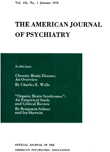DIFFICULTIES OF COMPARATIVE PSYCHIATRY: THE FIJI ISLANDS
Abstract
1. The complete psychiatric census of the Fiji Islands which has been taken periodically since 1911 meets some of the requirements for determination of the "true prevalence" of psychiatric disorders. It appears that such disorders were more frequent in the pre-industrial, pre-war era than in the later era of so-called "modern stress." The Fijian segment of the population experienced more change of social structure than the Indian segment, while the prevalance of psychiatric disorders apparently decreased among the former. Both these tendencies run counter to current popular beliefs.
2. Hospital admission rates are of little value in determining the incidence of psychiatric disorders, since they represent the tendency to seek hospitalization, rather than the need for hospitalization. This difficulty can be approached by the use of other appropriate information to devise a correction factor.
3. An apparent cultural or racial difference in the quantitative exhibition of psychopathology, by Fijians and Indians respectively, becomes less and less as more information is considered, until it can be shown with some likelihood that the actual rates are equal. It is not improbable that the actual rates are approximately equal all over the world.
4. Certain requirements for a scientific approach to comparative psychiatry are outlined, principally the use of more rigorous epidemiological methods, and the attenuation of the current bias toward "cultural" etiology with its obfuscation of other important possibilities.
Access content
To read the fulltext, please use one of the options below to sign in or purchase access.- Personal login
- Institutional Login
- Sign in via OpenAthens
- Register for access
-
Please login/register if you wish to pair your device and check access availability.
Not a subscriber?
PsychiatryOnline subscription options offer access to the DSM-5 library, books, journals, CME, and patient resources. This all-in-one virtual library provides psychiatrists and mental health professionals with key resources for diagnosis, treatment, research, and professional development.
Need more help? PsychiatryOnline Customer Service may be reached by emailing [email protected] or by calling 800-368-5777 (in the U.S.) or 703-907-7322 (outside the U.S.).



